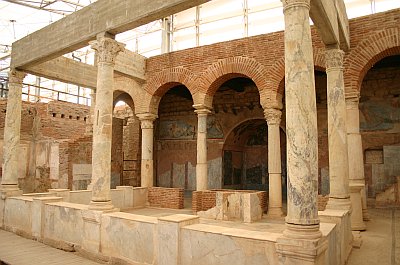TERRACE HOUSES OF EPHESUS
Terrace Houses

The light coming from the open peristyle illuminated the rooms, some of which remained dim or even quite dark because of this. The heating system was similar to that in the baths: clay pipes beneath the floors and behind the walls conducted hot air through the house.
The houses also had hot and cold running water. The toilets were similar to the public ones in Ephesus, only smaller: in the houses, as well, several people could use them at the same time. The system of drainage was relatively sophisticated. Waste water flowed through pipes to the street, and from there, to the main drainage pipe beneath Kouretes Street.
Two of these houses have been excavated, restored, and made open to the public. The first is known as "House A." It stands on a plot of land measuring 900 square meters. It once had two stories, but nothing of the upper one remains.
The main entrance led to the foyer, and to the ground floor, which consisted of twelve rooms. On one side of the fountain in the foyer, a staircase led to the upper story. An arch leads from the foyer to the peristyle. Four columns surround the peristyle, which was left open to the sky.
North of the peristyle are the remain i of a fountain, and behind this, two rooms, the floors of which are decorated with mosaics, and the walls, with frescoes. East of the peristyle is a room with extensive frescoes, the so-called Theater Room. On the right is a scene from the "Sikyonioi" by Menander, and on the left a scene from Euripides' "Orestes."
A further fresco depicts the struggle between the river god, Akhelaos, and Heraldes, over the favors of Deianeira. Mosaics cover the floor of this room. The bath and, next to it, the kitchen, lie south of this room.
Both black and white, as well as colored mosaics, decorate the court in front of the basin. Behind it is a particularly beautiful mosaic. It portrays Triton with his trident, the symbol of his father, Poseidon, in his left hand. With his right, he holds the reins of a seahorse, on which a Nereid (sea nymph) sits.
In the center of the peristyle is a well, surrounded by a basin that collected rainwater. Southwest of the peristyle, a staircase led to the upper story. South of the peristyle is the area called the "tablinium," the most beautiful part of the house, the vaulted roof of which is covered with a mosaic. The rooms on the east have floors paved with mosaics, and frescoes on the walls.
Other rooms include the "Room of the Muses," the bedroom, the kitchen, the toilet, the dining room, and the service room. In the "Room of the Muses," one sees frescoes portraying Thalia, the muse of comedy, Terpsikhore, the muse of dance, and Melpomene, the muse of tragedy.
In the kitchen is the "mesura," the stone that regulated the distribution of water and drainage. If water was not needed in one room or another, the openings of the "mesura" could be closed. An arched entrance leads to the toilets, which had space for use by several people at the same time.
In the Roman period, hospitality held high significance. Thus, the dining room was particularly beautifully appointed. Statues of influential ancestors were prominently displayed. It was the custom that the host, after dinner, would present laudatory speeches about his family.
Servants used both the dining room, called the "triclinium," and the service room to wait upon the guests.
Ephesus Tours by TSC Travel
Istanbul Travel Guide
Istanbul Shopping and Seafood
Istanbul Family Day Tour
Istanbul Mosques, Museums and Hamams
Bosphorus Tour, Istanbul
Istanbul Map
Central Istanbul Guide
History of Istanbul
The Foundation of Byzantion
Constantine The Great
The Age Of Justinian
Temple of Hadrian
Octagon
Brothel
The Byzantines At War
Ephesus
Temple of Artemis
City Walls
Koressos and Magnesian Gates
The State Agora
Temple of Isis Or Augustus
Basilica
Prytaneion
Bouleuterion
Temples of Julius and Roma
Latrine
Terrace Houses
Gate of Hadrian
Baths of Varius
Domitian Street
Memmius Monument
Round Monument
Relief of Nike
Fountain of Pollio
Temple of Domitian
Fountain of Gaius Laecanius Bassus
Kouretes Street
Gate of Herakles
Fountain of Trajan
Baths of Scholastikia
Turkey Packages
 Let's keep in touch
Let's keep in touch
If you have any enquiry, you may contact us using the form below.
Looking For Other Tour Packages?
If you are looking for other tour packages or hotel booking, you can search for it from our website or you can drop us an enquiry and we will try our best to return you the best possible package page for you to explore and consider your booking.